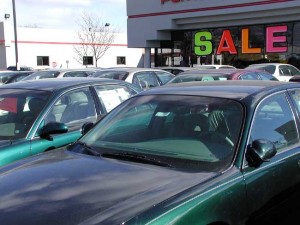
Used car prices peaked during the Great Recession, largely due to a shortage of "nearly new" vehicles.
After watching prices surge to record levels in the wake of the Great Recession, U.S. used car buyers are finally catching a break, with costs tumbling sharply on most models and likely to continue to slide through 2016, according to those who track pricing trends.
There are a few exceptions, such as pickup trucks, which have been in increasingly high demand as contractors and fleets rebound along with the economy. But there are great deals to be had on “nearly new” luxury cars and a number of other models, according to such experts as Tom Webb, the chief economist for Manheim, which runs some of the nation’s largest used vehicle wholesale auctions.
“Prices will continue to decline because of increased supply,” Webb told TheDetroitBureau.com, “mostly from off-lease vehicles.” The downward trend, he added, should continue for at least the next 18 months.
That’s particularly good news for those who want a like-new car, truck or crossover in good condition, with relatively low mileage, and often carrying the final portion of a factory warranty, Webb and other experts note.
(New car sales booming, but deals abound. Click Here to find out where the bargains are.)
Used car prices took what the Manheim economist called an “unprecedented” surge in 2008, hitting an all-time peak three years later and generally holding at above-trend numbers until now. The reason was Economics 101: a lack of supply. The used vehicle market depends on a steady supply of replacement vehicles as the oldest products are scrapped. But when the new car market fell to its lowest level in over a half-century as the economy collapsed, that meant fewer trade-ins and off-lease vehicles would be available, driving up prices.
The new car market has been rebounding even faster than anticipated, hitting about 15.5 million in 2013, while it is expected to top 16 million this year and keep growing. So, there is a growing supply of used vehicles available, driving down prices.
On top of that, lenders have been loosening the strings on loans to new car buyers, especially so-called sub-prime, or credit risky, shoppers. Add the fact that interest rates remain unusually low, and many motorists who might otherwise have opted for a used vehicle are buying something new, reducing demand. According to CNW Marketing, used-car sales slipped 1.9% in July compared to a year earlier.
That’s put further downward pressure on prices, though how much they already have and will continue to fall is a matter of debate. According to Manheim data, the market started turning downward in May. Webb said a typical midsize sedan that might have cost $15,000 in June was going for about 2% less a month later, or around $14,700.
(Toyota exec forecasts more growth for US new car market. Click Here for more.)
The Black Book, which tracks vehicle values for dealers, estimates the decline has been even steeper. Focusing on those nearly new, off-lease vehicles, it estimates that values at the dealer level slumped from an average $22,863 at the beginning of August 2013 to $20,463 by July of this year, an 11.8% decline.
“We anticipate this trend of accelerating depreciation will continue through the rest of the year,” said Ricky Beggs, Editorial Director at Black Book, “with smaller cars and luxury segments seeing higher levels of depreciation.”
Some of the biggest declines have come in the luxury segment, prices off 15.6% from a year ago, according to Black Book data. Manheim’s Webb, meanwhile says used car shoppers will likely find some great bargains in the compact and midsize passenger car segments.
On the other hand, Webb cautions that prices have actually risen on pickup trucks because of strong demand. And you may pay more for used compact and midsize crossovers – which have shown some of the fastest growth in the new car market.
(Click Here to find out how Millennials are reshaping the car-buying process.)
While the recent decline in used car prices may be good news for bargain hunters, there’s a flip side to the story. “Most used car buyers are also trading in a used car,” says Webb, adding that this likely means they will also get less money for the vehicle they’re getting rid of.
